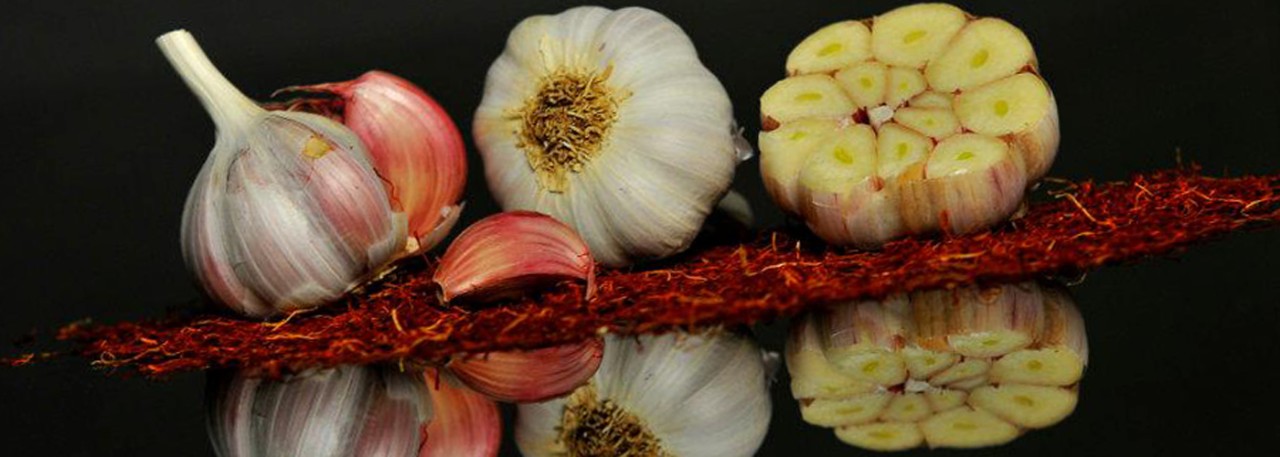.png.transform/rendition-xs/image_image%20(1).png)
Ajo Morado de Las Pedroñeras PGI
Bulbs of Allium sativum L., ecotype Morado de Las Pedroñeras, for consumption when dry.
Tasting notes
Strong smell and pungent, stimulating flavor. These characteristics are most obvious when a garlic clove is cut through, releasing the volatile compounds.
Other notes
The product is sold as whole heads in two categories - Extra or Class 1 - with a minimum diameter (of the peeled head) of 45 mm / 1¾ in for Extra and 41 mm / 1 5/8 in for Class 1. No more than one year may have passed since harvest.
Physical characteristics: the bulb or head is spherical or round and of medium size. The external skins are striated and white or slightly colored. The cloves are a characteristic purple or mauve color, also striated. They are small-to-medium in size, with a half-moon shape and white or yellowish flesh. There are no peripheral cloves.
Chemical characteristics: high content of very volatile, highly reactive organosulphates, rich in sulfur, iodine and silica, with interesting pharmacological activity. Especially high levels of allicin, which is largely responsible for the smell and flavor of garlic.
Production / Processing method
After preparing the ground and marking the rows, the crop is sown from early December to mid-January. Little dry-farming remains, with most of the land being irrigated. Average yield is 9-10 Tm/Ha/0.4 acres, but it can reach a maximum of 13 Tm/Ha/0.4 acres.
Harvesting is done in two stages. First, the tractor turns over the furrows, softening the ground and dumping the bulbs head down with their foliage on top. They are then collected by hand and removed out of direct sunlight. Work starts in the early hours and stops before midday. The bulbs are then formed into bundles and tied with one bundle to one side and the next to the other, forming sheaves. These sheaves are then transported to the place where drying takes place.
To remove any surplus moisture, the piles of bundles or sheaves are dried in the sun or using air blowers. The roots and leaves are then cut off and drying continues until the crop is delivered to the handling plants.
On reception, the degree of dryness and other requirements are checked. If accepted, the bundles are unloaded into a hopper, sorted and brushed to remove any broken or loose skins, then packed and stored. They may be kept at room temperature until 30 September of that crop year.
From then on, the product must be stored in facilities having controlled moisture and temperature conditions (from -2ºC to -4ºC / 35.6ªF to 39.2ºF). The cases or containers must be arranged to allow for ventilation. They must be marked with the date of reception. Garlic kept longer than one year after harvesting may not be sold under the PGI.
Geography / Relief and climate
The production area forms part of a large plain with very occasional hillocks and rivers flowing in deep gullies. The terrain comprises strata from the Jurassic to the Quaternary, with the oldest parts dating from the Mesozoic and forming folded structures in a north-south direction. The Lower Jurassic and Cretaceous are present but in general the terrain is largely tertiary. There are strips of formations from the Upper Neogene (Pliocene) which are good for garlic cultivation. One of these stretches from south Tarancón to close to the right bank of the Riansares river and comprises detritic continental marl, clay and sandy silt. Another stretches between Mota del Cuervo and Las Pedroñeras and comprises alternating continental marl, gypsum and sandstone. Another, from the left bank of the Záncara river to Casas de Guijarro, is made up of chalky or mixed gravel. The Quaternary can be found in the form of fine alluvial sediment, with the silt, sand and clay carrying high levels of organic matter and secondary gypsum.
Garlic is grown in the basins of the Guadiana, Júcar and Tagus rivers. The climate is continental or very continental. Sunshine is high, reaching an annual average of 2,738 hours. Average annual rainfall is 441 mm and the average annual temperature is 14.1ºC / 57.2ºF, varying between absolute means of 16.25ºC / 61.25ºF (January) and 41ºC / 105.8ºF (July).
Regulatory Council
Fundación C.R.I.G.P. Ajo Morado de Las Pedroñeras
Plaza Arrabal del Coso s/n
16660 Las Pedroñeras (Cuenca)
Tel: (+34) 967 139 333
info@igpajomorado.es
www.igpajomorado.es
Sources:
The cloves are a characteristic purple or mauve color, also striated.


- /content/dam/en/icex-foodswines/images/products/fruits---vegetables/ajo-morado-de-las-pedroñeras-pgi/Ajo%20Morado%20de%20Las%20Pedroñeras%20PGI%20carr1.jpg
- /content/dam/en/icex-foodswines/images/products/fruits---vegetables/ajo-morado-de-las-pedroñeras-pgi/Ajo%20Morado%20de%20Las%20Pedroñeras%20PGI%20carr2.jpg

Las Pedroñeras (Castile-La Mancha)
